All About Minerals
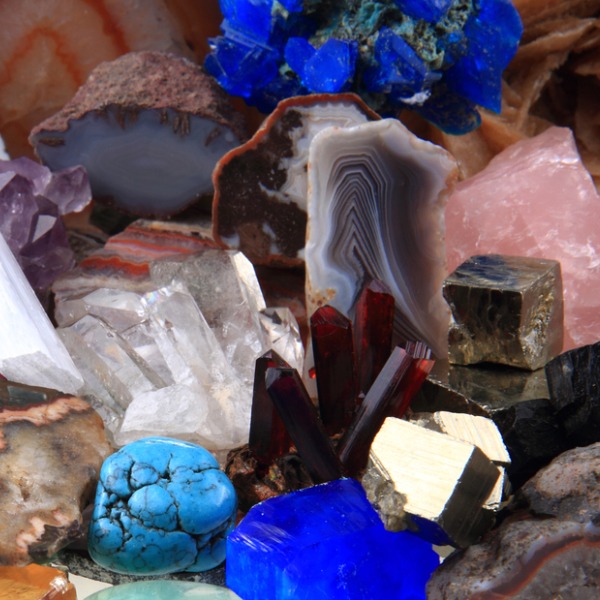
Assortment of minerals (jonnysek, iStockphoto)

Assortment of minerals (jonnysek, iStockphoto)
How does this align with my curriculum?
Learn about the characteristics and uses of minerals.
What Are Minerals?
Minerals are naturally occurring, solid, substances. They have a regular, repeating arrangement of atoms and molecules. The study of minerals is known as mineralogy. People who study minerals are called mineralogists.
Did you know?
Over 5 400 different minerals have been acknowledged to exist by the International Mineralogical Association (IMA). This international group is responsible for naming minerals and verifying new mineral discoveries.
How do people classify minerals?
Minerals can be described and classified according to their physical properties. There are a number of properties people look at.
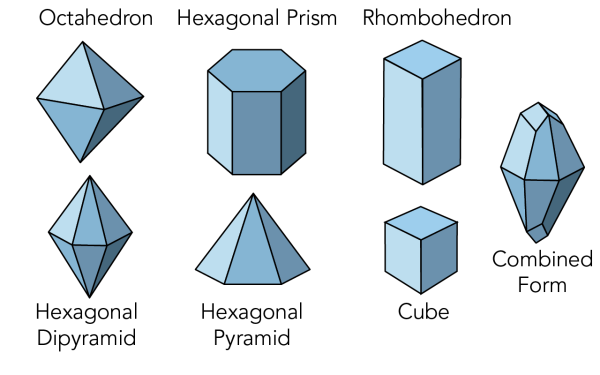
Image - Text Version
Shown is a colour illustration of seven different mineral shapes, with labels.
Each shape is pale blue, with a black outline, and a clack label.
Starting from the top left, the first shape is labelled "Octahedron." This looks like two pyramids, stuck together base to base. One pointing up and the other pointing down.
To the right, the second shape is labelled "Hexagonal Prism." This looks like a tall cake in the shape of a stop sign, with six sides, a hexagonal base, and a hexagonal top.
The third shape is labelled "Rhombohedron." This looks like a skyscraper, or an elongated cube, with two rectangular sides, a square base and a square top.
On the bottom left, the fourth shape is labelled "Hexagonal Dipyramid." This looks like two pyramids, with six sides each, stuck together base to base.
To the right, the fifth shape is labelled "Hexagonal Pyramid." This is one pyramid with six sides and a hexagonal base.
To the right, the sixth shape is labelled "Cube." This looks like a closed box with six square sides.
The seventh shape is labelled "Combined Form." This looks like a hexagonal dipyramid. But both points have been cut short by a two sided shape that looks like the roof of a house.
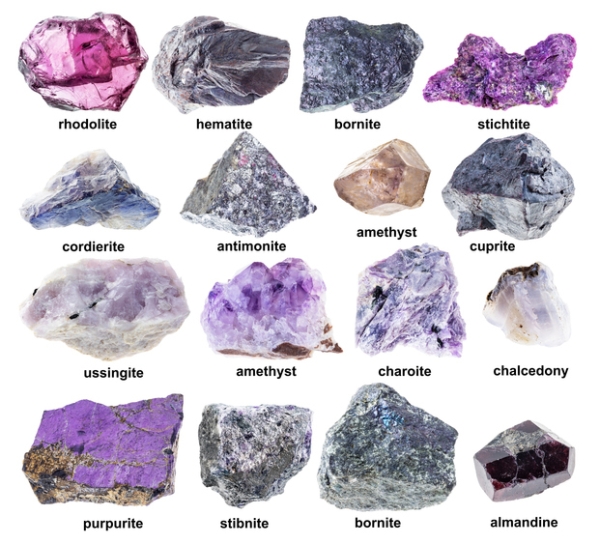
Image - Text Version
Shown is a chart of colour photographs of 16 minerals in different shades of purple, pink and blue.
There are four rows of four photographs on a white background. Each is labelled underneath in blank font.
Starting on the top left and moving right, the first is transparent, shiny, and purplish pink. This is labelled "rhodolite." The second is matte and dark greyish-purple streaked with white. This is labelled "hematite". The third is has a faint lustre, and is dark purple speckled with light purple. This is labelled "bornite." The fourth is bright purple with a rough texture and a few brown specks. This is labelled "stitchite."
In the second row, the fifth is blueish purple that fades to white. This is labelled "cordierite." The sixth is very shiny and purplish silver. This is labelled "antimonite." The seventh is translucent and pale peach shaded with very pale purple. This is labelled "amethyst." The eighth is rough and dark purplish grey. This is labelled "cuprite."
In the third row, the ninth is pale purple with a bubbly texture, and a white crust. This is labelled "ussingite." The tenth is dark purple at the top, and fades to white at the bottom. This is labelled "amethyst." The eleventh is rough, angular, and pale purple streaked with bright purple. This is labelled "charoite." The twelfth is translucent white with purple in the centre. This is labelled "chalcedony."
In the fourth row, the thirteenth is brown with a thin, bright purple layer. This is labelled "purpurite." The fourteenth is white speckled with pale grey and dark purple. This is labelled "stibnite." The fifteenth is grey with a purple gleam. This is labelled "bornite." The sixteenth is very deep reddish purple and shiny. This is labelled "almandine."
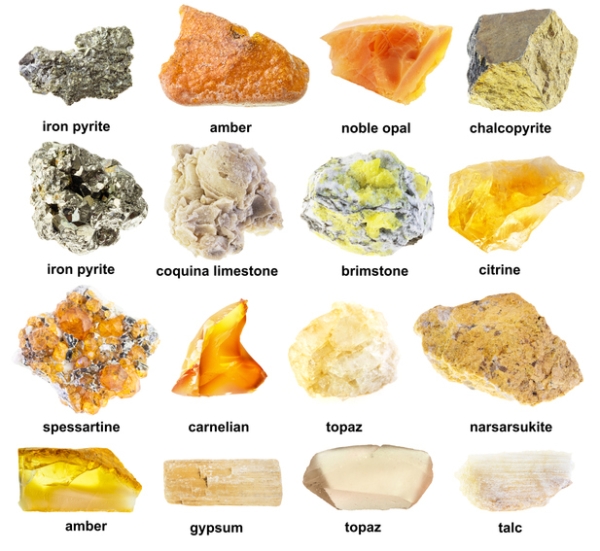
Image - Text Version
Shown is a chart of colour photographs of 16 minerals of similar colours but different lustres.
There are four rows of four photographs on a white background. Each is labelled underneath in blank font.
Starting on the top left and moving right, the first looks like dull, crumpled tinfoil with a gold sheen. This is labelled "iron pyrite." The second has the colour and texture of orange peel. This is labelled "amber." The third is slightly translucent and bright orange. This is labelled "noble opal." The fourth is pale greyish yellow that gleams gold in the light. This is labelled "chalcopyrite."
In the second row, the fifth looks like shiny tinfoil with a gold sheen. This is labelled "iron pyrite." The sixth looks a bit like a scoop of vanilla ice cream, shaded with pale purple. This is labelled "coquina limestone." The seventh is matte grey speckled with black and blobs of bright yellow. This is labelled "brimstone." The eighth shiny, translucent reddish gold. This is labelled "citrine."
In the third row, the ninth is shiny orange with ripples of what looks like shiny silver tinfoil. This is labelled "spessartine." The tenth is shiny, clear, and deep reddish gold. This is labelled "carnelian." The eleventh is translucent with a matte cream surface and pale gold interior. This is labelled "topaz." The twelfth looks like sponge toffee with flecks of grey. This is labelled "narsarsukite."
In the fourth row, the thirteenth is clear gold with a streak of reddish gold and a streak of cream. This is labelled "amber." The fourteenth is beige with a matte, powdery white surface. This is labelled "gypsum." The fifteenth opaque, matte cream with a light brown outer layer. This is labelled "topaz." The sixteenth is translucent cream with a gold interior and a white powdery surface. This is labelled "talc."
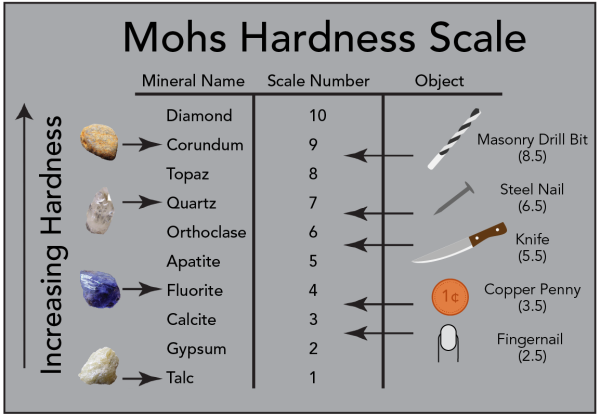
Image - Text Version
Shown is an illustrated colour chart of minerals and the objects they are scratched with to determine their number on Mohs Hardness Scale.
The title Mohs Hardness Scale is in large letters across the top of the image. Below is a table with three columns. The first has the heading "Mineral Name." The second is "Scale Number," and the third is "Object." Along the left edge, a long black arrow, pointing up, is labelled "Increasing Hardness."
The lowest mineral on the hardness scale is talc, with the number 1. Next is gypsum at 2 and calcite at 3. An arrow points from an illustration labelled "Fingernail (2.5)", to the space between 2 and 3.
The next hardest mineral is fluorite at 4. Another arrow points from an illustration labelled "Copper Penny (3.5)," to the space between 3 and 4.
The next hardest minerals are apatite at 5 and orthoclase at 6. A third arrow points from an illustration labelled "Knife (5.5)" to the space between 5 and 6.
Quartz is the next hardest mineral on the scale at 7. A fourth arrow points from an illustration labelled "Steel Nail (6.5)" to the space between 6 and 7.
Topaz, corundum and diamond are the hardest minerals on the scale at 8, 9, and 10. An arrow points from an illustration labelled "Masonry Drill Bit (8.5)" to the space between 8 and 9.
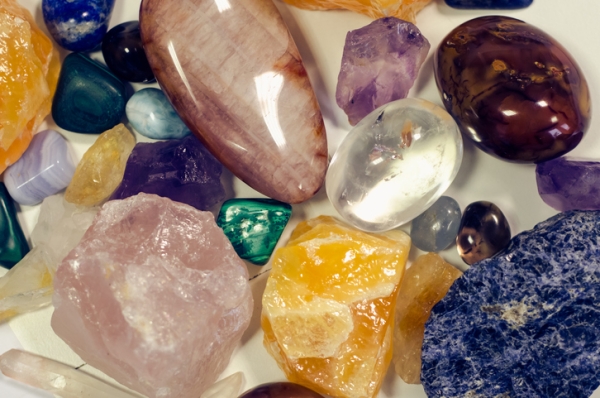
Image - Text Version
Shown is a colour photograph of 20-25 minerals on a white surface.
Each piece has a different colour, pattern and translucence. One egg-shaped piece is clear, like glass. Light passes through some pieces and bounces off the white background, brightening the colour of the mineral. The dark colour of one piece is visible through the pale grey of the one next to it. A seam in the background can be seen through a long, cloudy, colourless piece. The veins and internal patterns of some pieces are visible from the outside. But only the outer surfaces of others are visible.
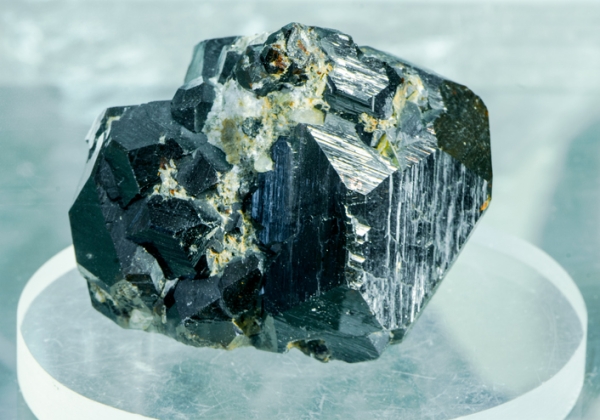
Image - Text Version
Shown is a colour photograph of a mineral with a surface of flat planes.
The mineral is shiny and dark grey. It looks as if it has been chipped and split into a generally round shape with many flat surfaces.
People also look at other characteristics such as how minerals react to substances such as acids or magnets.
How do people use minerals?
Minerals are used to make products that we use every day. This includes things like houses, pots and pans, electronics, batteries, automobiles and even fertiliser.
Valuable minerals include base metals, industrial minerals and precious metals.
- Base metals are metals such as copper, lead, iron, nickel, tin, zinc and aluminum.
- Precious metals are metals of high value, such as gold, iron and platinum.
- Industrial minerals are minerals that do not contain any metals.
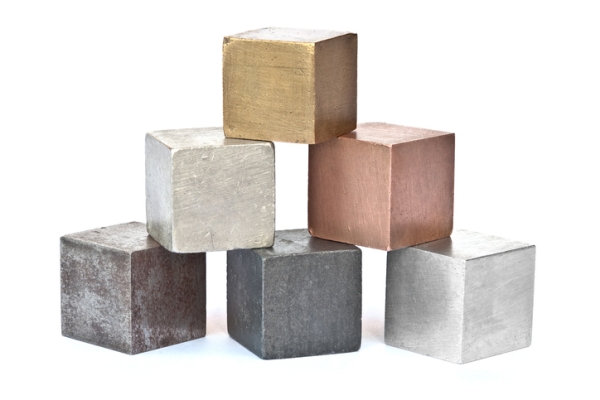
Image - Text Version
Shown is a colour photograph of six different metal cubes, stacked in a pyramid.
Each cube is the same size and shape, but a different colour.
In the bottom row, from the left, the first cube is silver mottled with dark greyish brown. The second is dark grey. The third is bright silver.
In the middle row, from the left, the first cube is bright silver with a yellow sheen. The second is reddish gold.
The top cube is yellowish gold shaded with dark grey.
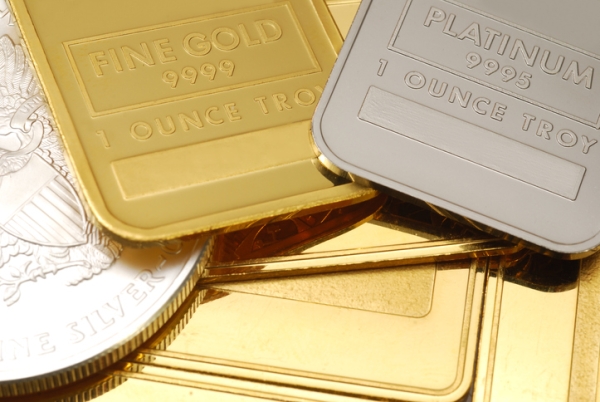
Image - Text Version
Shown is a colour photograph of a pile of metal bars and a coin.
The bars are the shape of a credit card, but thicker. The coin looks larger than any of the bars.
The coin is a bright, shiny silver. It is in between the bars, but the words "One Silver Dollar" are visible under a crest on its face. On top of the coin is a bright yellowish gold bar stamped with the words "Fine Gold 9999, 1 Ounce Troy." Over top of that is a darker silver coloured bar stamped with the words "Platinum 9995, 1 Ounce Troy." More gold coloured bars are visible beneath, but their stamps are covered.
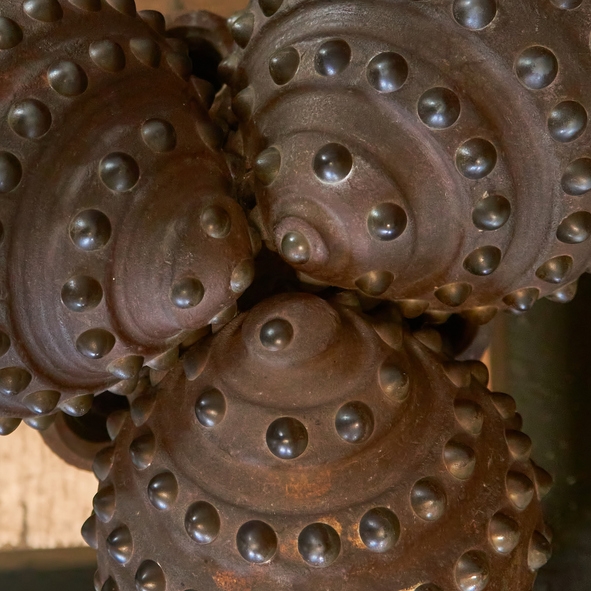
Image - Text Version
Shown is a colour photograph of a bit made of three metal cones mounted tip to tip.
The camera looks down on the end of the bit. The conical structures wide and dark reddish brown. Each one is ringed with small, round bumps that fit together like teeth when they rotate.
Learn More
Minerals in Your Daily Life
Learn about minerals used in everything from wind turbines, to toilets to toothpaste!
In what ways do you interact with minerals in your daily life? (2020)
In this video (4:58 min.) learn about the uses of minerals, where minerals come from and how we should use our mineral resources responsibly.
Identifying Mineral Samples (2014)
In this video (8:33 min.), learn about the various tests that can help in the identification of mineral samples.
Cut and assemble mineral crystal shapes
Cut and assemble your own 3D mineral figures out of paper.
Minerals for Kids
The Earth Science Museum at the University of Waterloo in Ontario has information and photos of a number of different minerals.
References
Encyclopaedia Britannica. (n.d.). Mineralogy.
Intrenational Mineralogical Association. (n.d.). About IMA.
King, H. M. (n.d.). Mohs hardness scale: A rapid hardness test for field and classroom use. Geology.com.
Leighty, R.S. (2022). Mineral Characteristics. GLG101N, Mesa Community College.
National Park Services. (n.d.). Rocks and minerals.
Newton, E. (August 19, 2020). Everyday Uses of Base Metals. Revolutionized.
OpenGeology (n.d.). Ore Deposits and Economic Minerals.